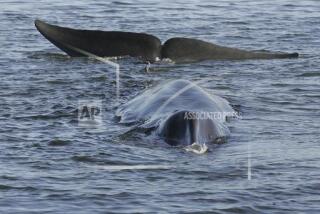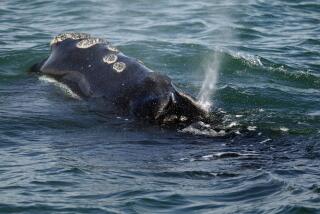Japanese whale hunters to target humpbacks
- Share via
SHIMONOSEKI, JAPAN — A Japanese whaling fleet left port today for a hunt that will include humpback whales for the first time in decades.
The whalers planned to kill as many as 50 humpbacks in what is believed to be the first large-scale hunt for the species since a 1963 moratorium put the giant marine mammals under international protection.
Japan’s annual research whaling mission is permitted by the International Whaling Commission, but anti-whaling activists call it a coverup for a commercial hunt.
Greenpeace and the animal rights group Sea Shepherd have said they would track the South Pacific hunt.
The fleet of four ships, accompanied by two observation vessels, was headed to the waters off Antarctica, according to Japan’s Fisheries Agency. The voyage is to run through April.
Along with the humpbacks, the fleet intends to take as many as 935 Antarctic minke whales and 50 fin whales in what the Fisheries Agency calls the largest scientific whale hunt ever conducted in the South Pacific. Marine biologists intend to study the whales, but meat from the catch will be sold commercially, as permitted by the whaling commission.
Japanese hunts have led to an international outcry, and the decision to kill humpbacks -- known for their distinctive knobby heads and out-of-the-water acrobatics -- has prompted special condemnation.
“These whales don’t have to die,” said Junichi Sato of Greenpeace. “Humpbacks are very sensitive and live in close-knit pods. So even one death can be extremely damaging.”
The American Cetacean Society estimates the global humpback population at 30,000 to 40,000, about a third of the estimated number before modern whaling. The species is listed as “vulnerable” by the World Conservation Union.
Japanese fisheries officials say the humpback population has returned to a sustainable level.
“Humpback whales in our research area are rapidly recovering,” said the Fisheries Agency’s whaling chief, Hideki Moronuki. “Taking 50 humpbacks from a population of tens of thousands will have no significant impact whatsoever.”
More to Read
Sign up for Essential California
The most important California stories and recommendations in your inbox every morning.
You may occasionally receive promotional content from the Los Angeles Times.










